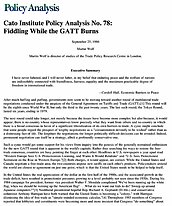Fiddling While the GATT Burns
I have never faltered, and I will never falter, in my belief that enduring peace and the welfare of nations are indissolubly connected with friendliness, fairness, equality and the maximum practicable degree of freedom in international trade.
–Cordell Hull, Economic Barriers to Peace
After much huffing and puffing, governments now seem to be moving toward another round of multilateral trade negotiations conducted under the auspices of the General Agreement on Tariffs and Trade (GATT).[1] This round will be the eighth since World War II, but only the third in the past twenty years. The last such round, the Tokyo Round, lasted six years, ending in 1979.
The next round could take longer, not merely because the issues have become more complex but also because, it would appear, there is no country whose representatives know precisely what they want from others and no country in which there is a broad consensus in favor of a significant liberalization of its own barriers to trade. A cynic might conclude that some people regard the prospect of lengthy negotiations as a “consummation devoutly to be wished” rather than as a distressing fact of life. The lengthier the negotiations the longer politically difficult decisions can be avoided. Indeed, permanent negotiation can itself be a strategy, albeit a profoundly conservative one.
Such a cynic would get some support for his views from inquiry into the genesis of the generally restrained enthusiasm for the new GATT round that is apparent in the world’s capitals. Rather than searching for ways to restore the free-trade consensus, countries are busy pointing the finger at each other. Headlines in U.S. newspapers a year apart read “Western Europe Sees U.S. Protectionism Looming, and Warns It Would Retaliate” and “U.S. Sees Protectionist Sentiment on the Rise in Western Europe.”[2] Both charges, it would appear, are correct. While the United States and Canada negotiate a free-trade area, the two countries impose new tariffs on each other’s products. Policymakers around the world are closest to agreement on just one point, which is that the United States needs to be helped to help itself.
In the United States the real appreciation of the dollar in the first half of the 1980s, and the associated growth in the trade deficit, have resulted in protectionist pressures growing to a level probably not seen since the 1930s. During his 1984 campaign for president, former vice president Walter F. Mondale complained ‘We’ve been running up the white flag, when we should be running up the American flag! …What do we want our kids to do? Sweep up around Japanese computers?”[3] Neoliberal presidential hopeful Rep. Richard A. Gephardt (D‑Mo.) and conservative columnist Anthony Harrigan have both warned that the United States is becoming a “colony,” with Harrigan dismissing the idea of free trade as “simple-minded economic calculus.”[4] Throughout 1985 members of Congress reported that lobbyists and constituents were becoming more and more insistent that Congress “do something” about the trade deficit and the perceived loss of jobs due to exports. Rep. John D. Dingell (D‑Mich.) demanded that the Japanese “stop engaging in the most outrageous trade practices ever,” while Sen. Alan J. Dixon (D‑Ill.) said, “The Japanese have done extremely well, to a large extent at our expense.”[5] The anti-Japanese rhetoric became so strong that Japanese-American members of Congress became concerned about its racial undertones.[6] This concern was presumably not eased when two unemployed auto workers in Detroit fatally beat a Chinese-American student because he looked Japanese to them–and a judge gave them suspended sentences.[7]
The principal and at present almost the only force of resistance to protectionism, it seems, is the administration. By virtue of his national mandate, a president is in a relatively good position to see both the general domestic interest in liberal trade and the international aspect. Ever since the Hawley-Smoot Tariff Act of 1930, Congress has by and large, if to a decreasing extent, been prepared to leave the initiative in trade policy to the administration, being well aware of the dangers of unrestricted logrolling on the matter. The administration, in turn, has justified its preponderant position by emphasizing the international dimension of trade policy. More precisely, it has stressed the need to negotiate trade policy with other countries. Congress has for the most part accepted the rationale and has been prepared to grant wide negotiating authority to successive administrations.
The need to get trade policy out of the hands of Congress and into those of the administration is the main political justification for another GATT round. It is not the intention here to question that rationale, which is a particular example of the “bicycle theory” of trade negotiations, the argument that, in the absence of international negotiations to liberalize trade, domestic pressures would increase protection in almost all countries. The “bicycle” of negotiations has to move forward, it is argued, if it is not to fall over. But to negotiate is not enough. Negotiations must aim at liberalization rather than the containment of protectionist pressures through market-sharing arrangements and other illiberal devices, as is now too often the case. What is negotiated and how are themselves important.
Accordingly, the question to be asked about the new GATT round is not whether it will take place, or even whether some agreement will be reached, but rather what should be talked about if the negotiation is to be more than an exercise in public relations. What are the problems in the international trading system to which the new GATT round might be a solution? And what sorts of agreements might actually represent a solution to those problems?
About the Author

This work is licensed under a Creative Commons Attribution-NonCommercial-ShareAlike 4.0 International License.
